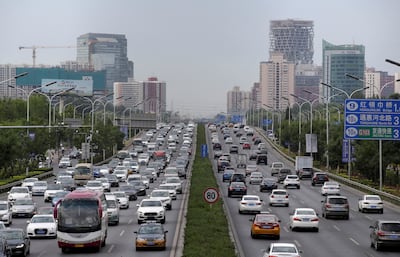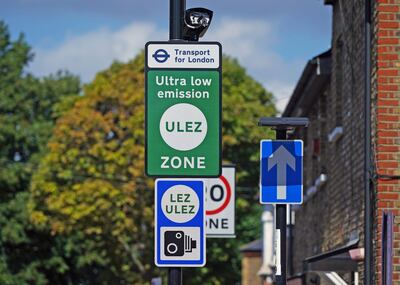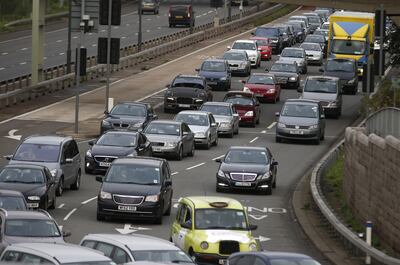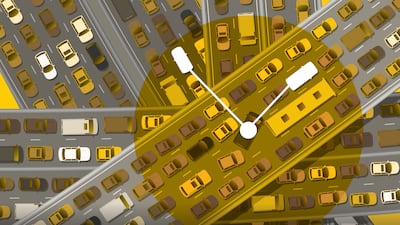Beleaguered London commuters, on average, spent almost an entire week stuck in traffic in 2022, highlighting an urgent need to tackle the human, economic and environmental cost of congestion.
Londoners endured a mind-boggling 156 hours grinding their gears during the year, just ahead of Chicago (155 hours), with Paris (138 hours), Boston (134 hours) and the Colombian capital of Bogota (122 hours) making up the top five congested cities, data compiled in the 2022 Global Traffic Scorecard from Inrix showed.
Drivers in the UAE may have their own tales of rush-hour traffic woe – Hessa Street in Dubai or the commute to Sharjah, for example – but they fared much better in the report.
Dubai motorists experienced 22 hours queued up behind the wheel and Abu Dhabi commuters were held up for 12 hours, the study found.
Before the pandemic, the figures were much higher, about 80 hours in Dubai and 50 hours in the capital.
Around the world, authorities have tried in numerous ways to reduce the incidence of traffic jams, with some approaches more successful than others.
Do more roads mean less traffic?
A common strategy is to increase capacity by building additional roads or adding lanes to existing motorways, but this typically has little lasting effect.
"If you increase the lane miles of roads in a city, the amount of driving … increases directly in almost exact proportion," said Matthew Turner, a professor in the department of economics at Brown University in the US and a former editorial board member of The Journal of Transport Economics and Policy.
While traffic speeds may increase on a road after it is widened, the effect is likely to be temporary and, even if it persists, will tend to be cancelled out by increased congestion elsewhere in the road network.

Another policy, introduced in, for example, Beijing and other Chinese cities, is to allow cars with only particular licence plates (such as those that end in certain numbers) to enter the city on a given day.
While the authorities have reported some success at reducing congestion, Prof Turner is doubtful that there are benefits.
"Those programmes are terrible," he said. "What happens is that people buy two cars. Because they have two cars instead of one, they’re older and dirtier. That’s not the way you want to go."
The threshold between free-flowing and gridlocked traffic is, he said, quite fine. If there are about 2,000 cars an hour per lane, a road is likely to be able to cope, but if the figure increases to about 2,200, logjams may result.
"You want to make sure that those marginal 200 cars never show up," Prof Turner said. "In most places, those 10 per cent of people are pretty price sensitive."
Are congestion charges the answer?
So congestion charging or congestion pricing is often the answer and has been implemented, in various forms, in cities including London, Milan, Rome and Stockholm. After decades of discussions, drivers will be charged for entering parts of Manhattan in New York from May next year.
Singapore is often seen as the poster child for this approach.
"You’re walking around central streets and cars are moving at free-flow speeds instead of the bumper-to-bumper you’re used to in a big city," Prof Turner said.
Systems may be time sensitive, because much of the problem is not that there are too many vehicles in total using a road, but that they are concentrated at particular times, such as at rush hours in the morning and late afternoon.
By being charged more for these peak times, drivers are encouraged to travel when roads are quieter or to choose public transport.
"You have to design the system carefully in terms of where the charges apply and what you charge people, what times of day you charge people, so you’re managing congestion without stifling the economy and exacerbating any equity issues there may be already in the transportation system," said Susan Handy, director of the National Centre for Sustainable Transportation at the University of California, Davis, and author of the forthcoming book Shifting Gears: Toward a New Way of Thinking about Transportation.
While charging drivers to enter particular areas may reduce congestion – and pollution levels – in those locations, Margaret Bell, science city professor of transport and the environment at Newcastle University in the UK, said that it can simply shift the congestion elsewhere.

Some such systems, such as London’s Ultra Low Emissions Zone or Ulez (which operates in addition to the city’s congestion charge) impose charges for vehicles that cause more pollution.
"Price-per-mile charging has been shown to be more effective than zone charging. I’m personally not a fan of zone charging," Prof Bell said.
"If, for example, people can’t afford to replace their cars to get cleaner vehicles, then they’re going to make longer journeys to avoid going into the zone.
"It costs them more in petrol but it also means that the roads that they use get more congested. You’re just switching the problem from the city centre on to the ring roads or the alternative routes."
Political considerations typically weigh heavily on decisions about what measures may be introduced.
"The number of cities that have actually implemented congestion pricing is still limited – some of the critical reasons for their non-implementation are public rejection and concerns," researchers wrote last year in Transportation Letters.
The expansion of London’s Ulez has sparked considerable opposition, including vandalism of the cameras that enforce the system and headlines about the authorities waging "war on motorists".
Amid heavy opposition, the council that manages the historic UK city of Cambridge recently abandoned plans to charge motorists £5 ($6.13) to enter at peak times, a move welcomed by some drivers but which sparked dismay among the clean-air campaigners who had pushed for the charge.

A 'first class' lane?
Another response to congestion is to have lanes set aside for public transport or vehicles of multiple occupancy. Other road users can pay to use such high-occupancy toll (Hot) lanes, with costs greater at peak times.
"Is that managing congestion? I don’t know," Prof Handy said. "It’s giving people a way to buy out of congestion when they need to. That can be helpful even for lower-income people: if they have to get somewhere fast, they have a way to do that."
Hot lanes have been introduced in many North American cities, among them Atlanta, Denver, Los Angeles, Miami and Toronto.
Another approach to reducing peak-hour congestion is to encourage flexible working, such as allowing employees to choose the hours they work, as long as they complete a certain number over a given period of days.
"If your concern is congestion rather than how much people are driving, then this approach of shifting when people are driving can be helpful," Prof Handy said.
Regulations requiring large employers to put in place programmes that encourage employees to come to work in ways other than by car have, she said, had "limited success".
Working from home, more common now than before the Covid-19 pandemic, can reduce demand at peak hours although, Prof Handy said, people who use a home office often tend to compensate for their lack of commuting by driving more at other times.

Another downside of working from home, Prof Bell said, is that people’s carbon emissions can actually increase compared with what they would be if they were commuting to the office, because individuals use air conditioning, heating or lighting more at home.
Better public transport, while it may not reduce congestion directly, according to some analysts, since it simply increases capacity of the whole system, does offer an alternative to road travel, so individuals are not forced to endure traffic jams if they have to travel.
A change of mindset
Prof Bell sees the solution to congestion in changes to lifestyle that reduce the need to travel. These may involve having more co-working spaces close to where people live.
"People need to start working more locally. Instead of 20 people working at home in separate buildings, we might invest in spaces, local offices, community offices, where people can go to work.
"That overcomes the carbon [emissions] impact. It also addresses the social isolation of people working from home for days on end."
If people can have access to everything they need within a short distance from where they are based, then congestion, even if it still exists, becomes less of a concern.
"It’s not necessarily something to be reduced, it’s something to be managed," Prof Handy said. "The way I like to think about it, the solution is not reducing congestion, it’s giving people an alternative to congestion.
"So if you create a city where it’s possible to get around without driving, where the kinds of services and activities that you need are within close proximity, congestion becomes less relevant to your life.
"Maybe that’s the solution to congestion, rather than our feudal attempts to reduce congestion."


